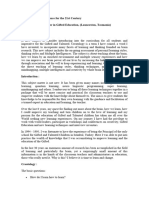0 ratings0% found this document useful (0 votes)
32 viewsRemotivation Technique 1
Remotivation Technique 1
Uploaded by
Axcel ChristianRemotivation therapy is a group therapy technique used with chronically mentally ill inpatients to stimulate communication, vocational, and social skills. It was developed in the 1950s by Dorothy Smith who read poems to non-communicative veterans, stimulating discussion. Remotivation involves choosing topics of interest, using props and materials to engage participants, asking open-ended questions to promote discussion, and summarizing sessions to emphasize important ideas and express appreciation for participants. The goal is to motivate patients to discuss real-world topics and practice social and communication skills.
Copyright:
© All Rights Reserved
Available Formats
Download as PDF, TXT or read online from Scribd
Remotivation Technique 1
Remotivation Technique 1
Uploaded by
Axcel Christian0 ratings0% found this document useful (0 votes)
32 views25 pagesRemotivation therapy is a group therapy technique used with chronically mentally ill inpatients to stimulate communication, vocational, and social skills. It was developed in the 1950s by Dorothy Smith who read poems to non-communicative veterans, stimulating discussion. Remotivation involves choosing topics of interest, using props and materials to engage participants, asking open-ended questions to promote discussion, and summarizing sessions to emphasize important ideas and express appreciation for participants. The goal is to motivate patients to discuss real-world topics and practice social and communication skills.
Original Title
REMOTIVATION-TECHNIQUE-1
Copyright
© © All Rights Reserved
Available Formats
PDF, TXT or read online from Scribd
Share this document
Did you find this document useful?
Is this content inappropriate?
Remotivation therapy is a group therapy technique used with chronically mentally ill inpatients to stimulate communication, vocational, and social skills. It was developed in the 1950s by Dorothy Smith who read poems to non-communicative veterans, stimulating discussion. Remotivation involves choosing topics of interest, using props and materials to engage participants, asking open-ended questions to promote discussion, and summarizing sessions to emphasize important ideas and express appreciation for participants. The goal is to motivate patients to discuss real-world topics and practice social and communication skills.
Copyright:
© All Rights Reserved
Available Formats
Download as PDF, TXT or read online from Scribd
Download as pdf or txt
0 ratings0% found this document useful (0 votes)
32 views25 pagesRemotivation Technique 1
Remotivation Technique 1
Uploaded by
Axcel ChristianRemotivation therapy is a group therapy technique used with chronically mentally ill inpatients to stimulate communication, vocational, and social skills. It was developed in the 1950s by Dorothy Smith who read poems to non-communicative veterans, stimulating discussion. Remotivation involves choosing topics of interest, using props and materials to engage participants, asking open-ended questions to promote discussion, and summarizing sessions to emphasize important ideas and express appreciation for participants. The goal is to motivate patients to discuss real-world topics and practice social and communication skills.
Copyright:
© All Rights Reserved
Available Formats
Download as PDF, TXT or read online from Scribd
Download as pdf or txt
You are on page 1of 25
REMOTIVATION TECHNIQUE
Prepared by: JOEL N. NEBRES, RN
Remotivation Technique
Remotivation refers to a variety
of group therapy techniques used
with chronically mentally ill
patients in inpatient settings to
stimulate their communication,
vocational, and social skills and
interest in their environment
Remotivation Technique
A Technique of a simple group
interaction between a member of
the nursing staff & a group of
patients.
Conducted by Psychiatric aides
who have had special instruction
in the technique
The National Remotivation Therapy
Organization (NRTO) defines remotivation
therapy (RT) as a small-group therapeutic
modality, designed to help clients by
promoting self-esteem, awareness, and
socialization
Remotivation therapy is a form of
intervention focused on the capabilities
and potential of individuals.
It aims at helping to value personal
strengths and to recognize specific
features, roles, and unique traits of the
patient.
Primary Aim:
To stimulate patients into thinking
about and discussing topics
associated with the real world.
It integrates several features of
other therapeutic intervention
modalities:
1. Reality Orientation
2. Reminiscence
3. Validation
4. Sensory stimulation
Origin and Development of
Remotivation Technique/ Therapy
Dorothy H. Smith, a retired English teacher who
was a volunteer at the Northampton,
Massachusetts, Veterans Administration
Hospital, started the practice of Remotivation in
1950
She moved to Massachusetts and became a
volunteer in a veterans hospital whose patients
were returning from WWII, and were
traumatized from the effects of war.
She was told there was no hope for these
men. Mrs. Smith wanted to work with the
most regressed of what we now call PTSD
patients. These men were so traumatized
that they were unable to care for them
selves, eat, communicate or sleep.
She sat down and began to read a poem.
“The Santa-Fe Trail” by Vachel Lindsey But
Mrs. Smith prevailed and began to go to
the units that housed the men that were
not talking or communicating in any
manner. Some hid under a piano!
This is Part of the POEM….
“The hand cars whiz and rattle on the rails. The
sunlight flashes on the tin dinner pails.”
As the men listened to the rhythmic sway of the
poem, they began to draw nearer to Dorothy. She
continued to read the poem and at the end asked
one question.
And this started the conversation, “Has anyone ever
been to Santa-Fe?” One of the men responded “yes”.
Then another asked her to read the poem again.
Eventually all but 2 of the men were
reading out loud and actually began to
communicate verbally once again! They
were answering simple questions with
sensible answers. Before too long the group
increased from a few non communicative
men to a group of 14.
Thus, started the Remotivation therapy
The topics must be of interest to the group members, which
could be confirmed through prior conversations with them
but also with their families and staff members.
The use of tools can compensate sensory losses and
enhance attention.
The use of texts from magazines and newspapers, music
and songs, and pictures and photographs instead of poetry
(as initially defined by Dorothy Smith) works best with
participants with regressing mental abilities and lower
education levels (Arau´jo et al. 2011).
• To give each person a hands-on project
relating to the subject, using props
(e.g., flowers in a session about
seasons, dolls and toys in a session
about traditional games) is essential to
promote participation and facilitate the
understanding of the topics
How to do this:
Discussion methods are used to motivate
the group’s interest and participation
A meeting is held with a group of 10-12
patients a week for about an hour
Each meeting being focused on a specific
topic chosen for discussion
Five steps essential to a
emotivatio :
Step 1. Climate of acceptance
The Remotivator introduces
himself/herself and welcomes each
person on his or her arrival in a
warm, friendly manner and assists
in finding a seat or wheelchair
space in the circle.
Step 2. Bridge to the rea world/ Reality
The Remotivation introduces a
general topic that would be
relevant to the group.
Also texts from magazines and
newspapers as well as citations
can be used. The texts must be
simple, rhythmic, and related to
the topic under exploration
Ang Kawayan
Ang Punong Kawayan Sa isang bakuran,
may ilang punungkahoy na may kanya-
kanyang katangian. Mabunga ang Santol,
mayabong ang Mangga, mabulaklak ang
Kabalyero, tuwid at mabunga ang Niyog.
Ngunit sa isang tabi ng bakuran ay
naroroon ang payat na Kawayan.
Minsan, napaligsahan ang mga punungkahoy.Tingnan
ninyo ako, wika ni Santol. Hitik sa bunga kaya mahal ako
ng mga bata.Daig kita, wika ni Mangga. Mayabong ang
aking mga dahon at hitik pa sa bunga kaya maraming
ibon sa aking mga sanga.Higit akong maganda, wika ni
Kabalyero. Bulaklak ko'y marami at pulang-pula. Kahit
malayo, ako ay kitang-kita na.Ako ang tingnan ninyo.
Tuwid ang puno, malapad ang mga dahon at
mabunga,wika ni Niyog. Tekayo, kaawa-awa naman si
Kawayan. Payat na at wala pang bulaklak at bunga.
Tingnan ninyo. Wala siyang kakibu-kibo. Lalo na siyang
nagmumukhang kaawa-awa.Nagtawanan ang mga
punungkahoy.
Pinagtawanan nila ang Punong
Kawayan.Nagalit si Hangin sa narinig na
usapan ng mga punungkahoy. Pinalakas niya
nang pinalakas ang kanyang paghiip. At isang
oras niyang pagkagalit ay nalagas ang mga
bulaklak, nahulog ang mga bunga at
nangabuwal ang puno ng mayayabang na
punungkahoy. Tanging ang mababang-loob
na si Kawayan ang sumunud-sunod sa hilip
ng malakas na hangin ang nakatayo at di
nasalanta.
Along with reading and analyzing
a text, visual aids, pictures, and
other objects that are related to
the topic can be used.
It is important to ensure that all
participants have contact with
the materials.
Step 3. Appreciation for the
work of the world
The remotivator develops the topic
through planned, open-ended,
factual, and objective questions,
promoting discussion and
interaction between participants.
Materials appealing to the group
members should be used.
Step 4. Sharing the world we
live in
The Remotivator must stimulate the
group members to think about the
topic in relation to themselves and
their realities
the questions must call for
subjective aspects of the topic, such
as the participants’ past experiences
and reminiscences, personal
opinions, and points of view.
Step 5. Climate of appreciation
The remotivator provides a brief
summary of the session
emphasizing the most important
ideas exchanged between
participants
It is also time to express
appreciation for the participants’
attendance and contributions.
The remotivator ends with
information on the following session,
inviting the group members, and
transmitting a sense of continuity.
During the sessions the remotivator
must not assume the role of a
lecturer. Instead, the remotivator
must speak in a nonthreatening and
nonjudgmental manner, regardless of
the participants’ response to the
presented topic.
The Remotivation seeks:
a. active listening
b. verbalizing appropriately in discussions
c. attentiveness to the activity
d. ability to remain on task
e. responding to reality cues
f. accepting redirection
g. making an effort to communicate with
other group members
h. demonstrating or expressing positive
feelings in group
You might also like
- Still Life Drawing RubricDocument2 pagesStill Life Drawing Rubricapi-29322841188% (8)
- 1 - Q2 Oral CommDocument10 pages1 - Q2 Oral Commサビーネ ジェイNo ratings yet
- Social Identity Wheel Activity - Facilitator InstructionsDocument5 pagesSocial Identity Wheel Activity - Facilitator Instructionsapi-282764739No ratings yet
- Introduction To Humanities: Lori-Beth LarsenDocument70 pagesIntroduction To Humanities: Lori-Beth LarsenCharmaine JanorasNo ratings yet
- Waldara Answers - Book 1Document42 pagesWaldara Answers - Book 1Justin YarbroughNo ratings yet
- Remotivational TherapyDocument10 pagesRemotivational TherapyCaress Mae Gubaton Cabudoy100% (2)
- Person-Centered Arts Practices with Communities: A Pedagogical GuideFrom EverandPerson-Centered Arts Practices with Communities: A Pedagogical GuideRating: 5 out of 5 stars5/5 (1)
- Types of Text:: by Ms. BennettDocument30 pagesTypes of Text:: by Ms. BennettYanyan Educ100% (1)
- Multiple Intelligences: Mohd Fitri Mohamad Ananthan NadarajanDocument29 pagesMultiple Intelligences: Mohd Fitri Mohamad Ananthan NadarajanAnantha De Shirota100% (1)
- Giver Edguide v4bDocument28 pagesGiver Edguide v4bapi-337023605100% (1)
- Geed 20142 Business Logic PDFDocument91 pagesGeed 20142 Business Logic PDFpaulo viloria100% (2)
- Remotivation Therapy ModuleDocument5 pagesRemotivation Therapy Moduledennielle valdez100% (1)
- Ramon SantosDocument15 pagesRamon SantosKench ClaverNo ratings yet
- Olga Conversation Activity 1,2,3Document20 pagesOlga Conversation Activity 1,2,3GTNo ratings yet
- Lesson Plan in English 7Document12 pagesLesson Plan in English 7Ronell CharcosNo ratings yet
- Adult Learning 1997 Brougher 28 9Document3 pagesAdult Learning 1997 Brougher 28 9larisa4petrinciucNo ratings yet
- Healing Workshop OutlineDocument24 pagesHealing Workshop OutlineJanet Escosura Espinosa MadayagNo ratings yet
- ME EngOCC 11 Q1 0401 - PS - What Are Speech ContextsDocument28 pagesME EngOCC 11 Q1 0401 - PS - What Are Speech ContextsLj San FelipeNo ratings yet
- Debriefing ToolsDocument7 pagesDebriefing ToolsDragos-Cristian FinaruNo ratings yet
- Psychotherapy Notes 3Document9 pagesPsychotherapy Notes 3Reniella HidalgoNo ratings yet
- Types of Speech in Context g11Document26 pagesTypes of Speech in Context g11Camille FaustinoNo ratings yet
- Early Recollections As A Counselling TechniqueDocument3 pagesEarly Recollections As A Counselling TechniquestifenNo ratings yet
- Unit I: Communication Processes, Principles, and Ethics: Prepared By: Ms. Aga Emm D. Mahinay, MaedDocument71 pagesUnit I: Communication Processes, Principles, and Ethics: Prepared By: Ms. Aga Emm D. Mahinay, MaedMr. JaydieNo ratings yet
- The Seven Perceptual Learning StylesDocument3 pagesThe Seven Perceptual Learning StylesRamona FloreaNo ratings yet
- Types of Speeches and Principles of Speech Writing and DeliveryDocument46 pagesTypes of Speeches and Principles of Speech Writing and DeliveryRomnick BistayanNo ratings yet
- Camus, Niña Angela L. (Case Study) PDFDocument3 pagesCamus, Niña Angela L. (Case Study) PDFNiña AngelaNo ratings yet
- Speech Communication: The SCIENCE and Art of PersuasionDocument68 pagesSpeech Communication: The SCIENCE and Art of Persuasionpragna927No ratings yet
- Week 2Document5 pagesWeek 2sherry anonuevoNo ratings yet
- 1 Nature & Elements-of-CommunicationDocument35 pages1 Nature & Elements-of-CommunicationMichelle BautistaNo ratings yet
- Example of A Thesis Statement For An EssayDocument7 pagesExample of A Thesis Statement For An Essayafibxprddfwfvp100% (2)
- Subjects Method Skills EncryptedDocument12 pagesSubjects Method Skills EncryptedEsio TrotNo ratings yet
- Listen A Seeker's Resource Issue 6.2Document8 pagesListen A Seeker's Resource Issue 6.2Spiritual Directors InternationalNo ratings yet
- Communication: Il/, Hoin, ElirhrDocument10 pagesCommunication: Il/, Hoin, ElirhrMuhammad Humza GhayasNo ratings yet
- M1 Understanding the Audience Audience Analysis 1 3Document8 pagesM1 Understanding the Audience Audience Analysis 1 3jimbradix132No ratings yet
- C6 Tree of Life Community ContextDocument15 pagesC6 Tree of Life Community ContextamybaddeleyNo ratings yet
- Social Self 2023Document37 pagesSocial Self 2023Odchigue, Axl Rose - WU-PNo ratings yet
- Learning Styles of ChildrenDocument25 pagesLearning Styles of Childrenericaestimar13No ratings yet
- Subjects Method SkillsDocument11 pagesSubjects Method Skillssancho23100% (1)
- M1 Understanding-the-Audience-Audience-AnalysisDocument10 pagesM1 Understanding-the-Audience-Audience-AnalysisandoygentallanNo ratings yet
- Comm 3 - Final Speech Outline On EmpathyDocument4 pagesComm 3 - Final Speech Outline On EmpathyRachel AsuncionNo ratings yet
- FullDocument74 pagesFulljeannaacosta423No ratings yet
- CS-OC-I-11-WK7Document23 pagesCS-OC-I-11-WK7andreideguia55No ratings yet
- Toward A Philosophy of CommunicationDocument4 pagesToward A Philosophy of CommunicationEtranger15No ratings yet
- Self Psychology: Overview: and ApplicationsDocument18 pagesSelf Psychology: Overview: and Applicationsmaharajsaini4229No ratings yet
- General StrategiesDocument12 pagesGeneral StrategiesKristine Monique PanzaNo ratings yet
- Creat OlogyDocument6 pagesCreat OlogyBeatriz ManriqueNo ratings yet
- CMAP Exam ReviewDocument4 pagesCMAP Exam Reviewsulump5No ratings yet
- Creative Writing and NatureDocument5 pagesCreative Writing and NatureFrancis GilbertNo ratings yet
- Some Basic Principles of Good TeachingDocument1 pageSome Basic Principles of Good TeachingneofitaNo ratings yet
- Ap4 2Document3 pagesAp4 2api-316130274No ratings yet
- Hand Outs Q1 M5 7 English 10Document3 pagesHand Outs Q1 M5 7 English 10johnbernardrempis4No ratings yet
- Eng 101Document19 pagesEng 101kim8queNo ratings yet
- History Taking and MSE AIIMS PatnaDocument34 pagesHistory Taking and MSE AIIMS PatnaShivendra Kumar100% (1)
- Do Apes Read Minds?: Toward a New Folk PsychologyFrom EverandDo Apes Read Minds?: Toward a New Folk PsychologyRating: 3.5 out of 5 stars3.5/5 (1)
- Ian KerrDocument91 pagesIan Kerrnini345No ratings yet
- Thinking and Language MODULE 3Document62 pagesThinking and Language MODULE 3shreya.karNo ratings yet
- Intercultural and Globalization1Document36 pagesIntercultural and Globalization1varnesredNo ratings yet
- Art Therapy Dissertation TopicsDocument8 pagesArt Therapy Dissertation TopicsBuyingPaperCanada100% (1)
- Peters (1999) Client Centered Therapy in The Care of The Mentally HandicapedDocument15 pagesPeters (1999) Client Centered Therapy in The Care of The Mentally HandicapedNicole Maldavsky BrillNo ratings yet
- 3) The Macro Skills - ListeningDocument56 pages3) The Macro Skills - ListeningArtchie BurcaNo ratings yet
- Participate in Workplace Communication-Final TTLMDocument36 pagesParticipate in Workplace Communication-Final TTLMmohammed ahmedNo ratings yet
- Functions of Communication: Lesson 7Document6 pagesFunctions of Communication: Lesson 7Aldrine RegalaNo ratings yet
- ClassroomDocument8 pagesClassroomIreneIreneNo ratings yet
- FINAL COPY Thesis and Disertation Writing Guide For Implementation Starting 1st Sem 2021 2022 1Document19 pagesFINAL COPY Thesis and Disertation Writing Guide For Implementation Starting 1st Sem 2021 2022 1roselyn padorNo ratings yet
- Monitoring and Controlling Service ProvisionDocument8 pagesMonitoring and Controlling Service Provisionneil.winter342No ratings yet
- 2022 COBEE Math Marking GuideDocument2 pages2022 COBEE Math Marking Guidehambobwenigu530No ratings yet
- Lesson 5 Life Skills To Improve Sexual HealthDocument20 pagesLesson 5 Life Skills To Improve Sexual HealthJOSE IÑIGO V. MARTINEZ100% (1)
- Thesis Driven Synthesis Essay ExampleDocument5 pagesThesis Driven Synthesis Essay Exampledwf6nx2z100% (1)
- BIOL 109 Intro To Biological Science Peterman PDFDocument6 pagesBIOL 109 Intro To Biological Science Peterman PDFSherryl V MorenoNo ratings yet
- Rta SynopsisDocument3 pagesRta SynopsisRomy Jan AmargaNo ratings yet
- Blended OnlineDocument10 pagesBlended OnlineNhormer PedrinaNo ratings yet
- Introduction To HistoryDocument26 pagesIntroduction To HistoryVirgilio ManalangNo ratings yet
- Grammar Workshop Word FormDocument2 pagesGrammar Workshop Word FormWide SkyNo ratings yet
- Timothy James Haggerty: ObjectiveDocument1 pageTimothy James Haggerty: ObjectiveTim HaggertyNo ratings yet
- PCM Unit Short Story WritingDocument31 pagesPCM Unit Short Story Writingapi-253146124No ratings yet
- Efektivitas Organisasi Pemerintah Kecamatan Wanea Kota Manado Vicky Switly Toad Joyce J. Rares Jericho D. PombengiDocument7 pagesEfektivitas Organisasi Pemerintah Kecamatan Wanea Kota Manado Vicky Switly Toad Joyce J. Rares Jericho D. PombengiHilda Tiara LucardoNo ratings yet
- Pt. RAVISHANKAR SHUKLA UNIVERSITY Student Result PageDocument1 pagePt. RAVISHANKAR SHUKLA UNIVERSITY Student Result PagepaikaratriloksinghNo ratings yet
- Winter Games 2018: Reading Comprehension PacketDocument7 pagesWinter Games 2018: Reading Comprehension PacketRania MohammedNo ratings yet
- Thalasha Brown Resume Copy Copy 1Document2 pagesThalasha Brown Resume Copy Copy 1api-482577310No ratings yet
- ARTAPP - Quiz 1 - Assumptions and Nature of ArtsDocument3 pagesARTAPP - Quiz 1 - Assumptions and Nature of ArtsChristian Ervhen LaguatanNo ratings yet
- Howtopracticesnare PDFDocument13 pagesHowtopracticesnare PDFBastiaoNo ratings yet
- Crypto MidsemDocument1 pageCrypto MidsemSUBODH SINGHNo ratings yet
- Infinitive and Gerund PatternsDocument2 pagesInfinitive and Gerund PatternsNanga ParbatNo ratings yet
- First PTA Meeting ProgramDocument2 pagesFirst PTA Meeting ProgramFernan Enad100% (2)
- Aadesh Pathare Slip Belt Micro ProjectDocument17 pagesAadesh Pathare Slip Belt Micro ProjectAKASH THORATNo ratings yet
- Immunizationcoverageamongmigratorypopulation RajkotcityDocument283 pagesImmunizationcoverageamongmigratorypopulation RajkotcityjahnavinavamiNo ratings yet
- Aims and Objectives of Teaching Mathematics-2Document25 pagesAims and Objectives of Teaching Mathematics-2Punitha asokanNo ratings yet
- Types of Leaves: Sick Leave/Medical LeaveDocument5 pagesTypes of Leaves: Sick Leave/Medical LeaveAhmed AbdullahNo ratings yet
- Daftar Pustaka: Engineering, Prentice Hall Inc, New JerseyDocument2 pagesDaftar Pustaka: Engineering, Prentice Hall Inc, New JerseySurya Darma SatriaNo ratings yet
- Lesson 11 Homework 2.3Document7 pagesLesson 11 Homework 2.3cffge1tw100% (2)

























































































